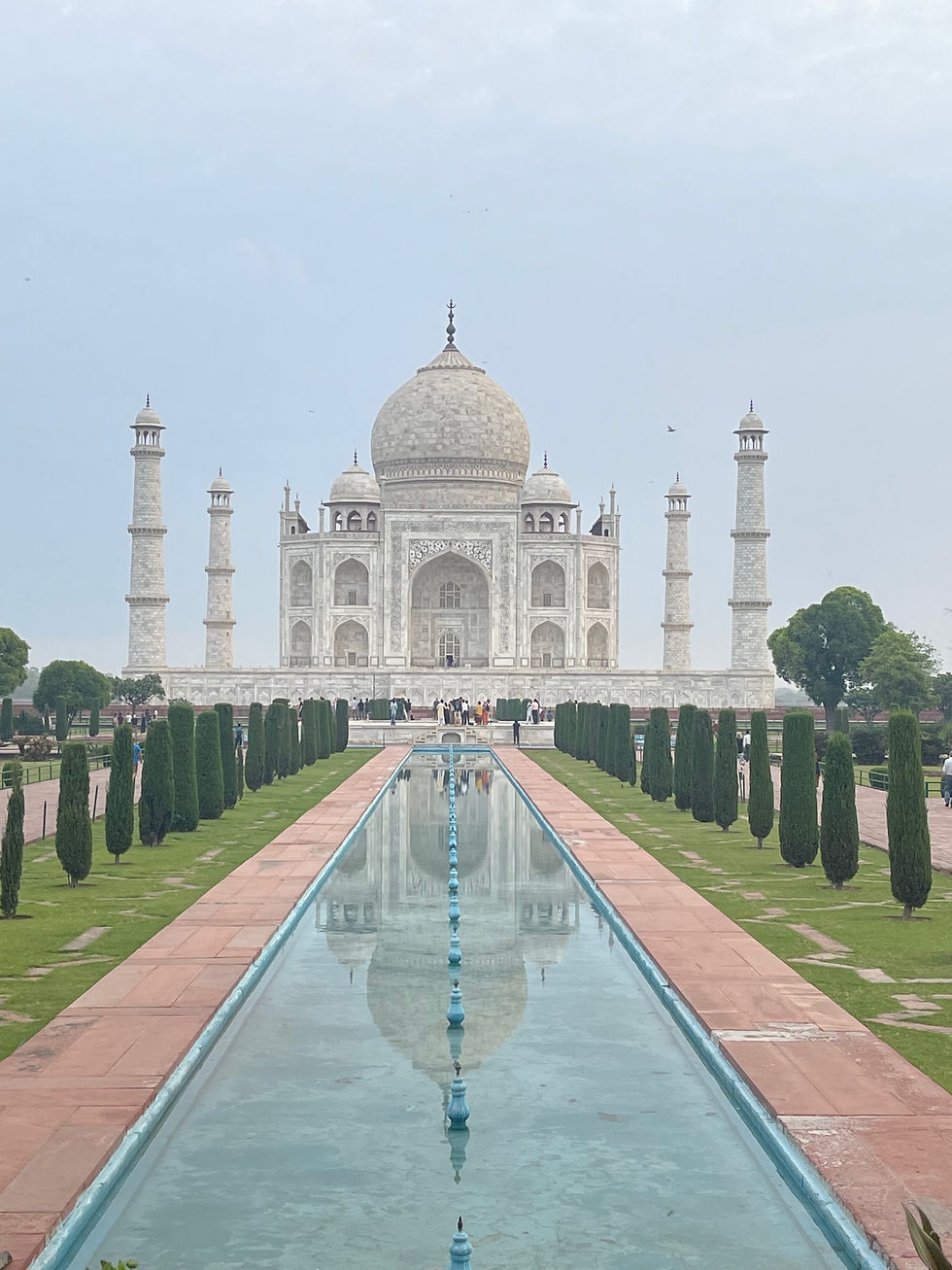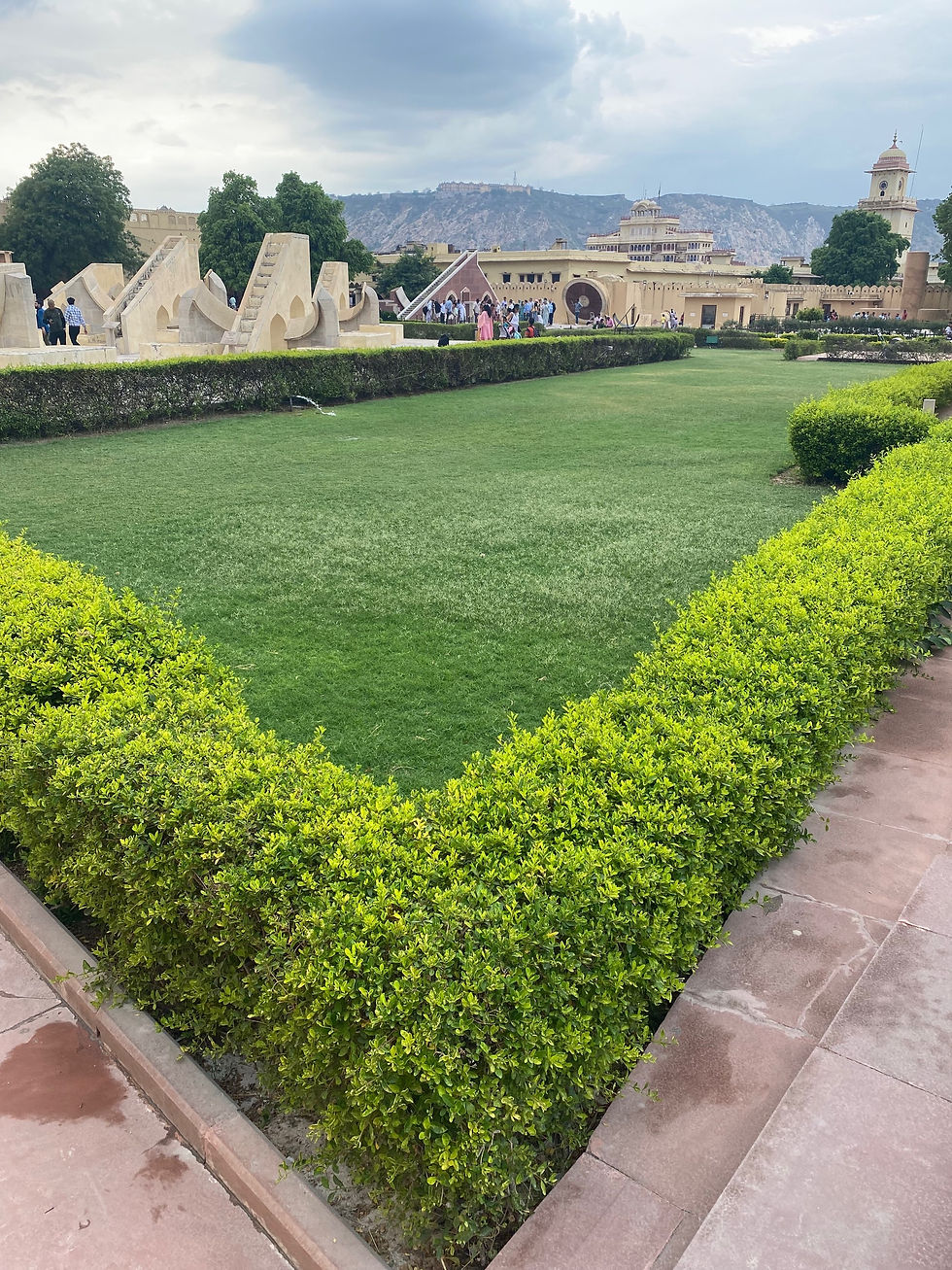India - Part 2
- abundantlyclare

- Apr 16, 2024
- 7 min read
On April 29th, Chloë, Peter and I woke up early for our sunrise tour and first up-close visit to the Taj Mahal. Now it’s finally time for me to relay the story of the Taj Mahal. Disclaimer: I do not pretend to be an expert on the Taj Mahal, by any means! But this is what I remember of how it was relayed to me by our wonderful tour guide (with some additional help by Wikipedia).
No offense taken if you don't care about the story of the Taj Mahal; feel free to scroll on by down to the photos!
The Taj Mahal was built by Shah Jahan I, who ruled the Mughal Empire from 1628 to 1658. As was a custom of the time, he had multiple wives. His second wife, Mumtaz Mahal, was a Muslim Persian princess, and she was his favorite wife, considered by many to be his soulmate. They had nearly 20 happy years together. She joined him on a campaign to crush a rebellion in Burhanpur, despite being heavily pregnant. She went into labor with their 13th (or maybe 14th, depending on the source) child, and unfortunately, she didn’t survive (The child did, thankfully!). On her deathbed, she knew her husband would be distraught, so she came up with a project for him to keep him occupied and to distract himself from his grief. She asked him to build her a tomb to honor their love, and to visit the tomb every year on the anniversary of her death. He promised her he would, and upon her death, he dreamed up the Taj Mahal.
There’s no doubt in my mind that when Mumtaz Mahal asked for a tomb, not in her wildest dreams would she have envisioned something as grand as the Taj Mahal. But when Shah Jahan undertook the building of the Taj Mahal, he declared no expense would be spared. He brought the best artisans and craftsmen from all over the world, offered them whatever pay they asked for, and used only the best of all materials. The Taj Mahal is constructed of white marble, and decorated with precious and semi-precious stones including jade, jasper, turquoise, lapis lazuli, sapphire, and amethyst. The Taj Mahal took 22 years to build and cost what would be the equivalent of $500 million today.
So during this 22-year process, Shah Jahan and Mumtaz Mahal’s children grew into adults. Shah Jahan’s favorite son was his sixth child, Aurangzeb, who eventually started to take issue with his father wasting so much of their family’s money on this crazy project. The main tomb of the Taj Mahal was completed in 12 years but Shah Jahan continued building it out for another 10 after that, and Aurangzeb started to get frustrated that his father was just pouring money down the drain. He tried to take it up with his older brother, the crown prince Dara Shikoh, but his brother told him to drop it and that it was their mother and father’s legacy. Tensions started to rise in the family and then Shah Jahan fell ill. Dara Shikoh became regent in his father’s stead, but his three younger brothers, including Aurangzeb, took issue with that. The other two brothers marched on Agra to claim their share of riches, but Aurangzeb showed up as the commanding officer of a formidable army. He fought his brother’s forces and defeated him, then had his three brothers executed. By now, Shah Jahan's health had improved and he no longer needed a regent, but Aurangzeb deemed him unfit to rule and took over the empire. He imprisoned his father in the Agra Fort and kept him on house arrest for 8 years until he died. Aurangzeb wouldn't even allow Shah Jahan out of his prison to visit the Taj Mahal on Mumtaz Mahal's death anniversary, so he broke one of his final promises to her.
Annoyingly, Aurangzeb went on to be the longest-reigning Mughal emperor of all time, and his reign was associated with rapid military expansion. Under his reign, the Mughal empire grew to its largest size, and they also became the world's largest economy and biggest manufacturing power. However, some historians argue that his emperorship was the beginning of the end of independence for India. He was staunchly conservative and anti-religious freedom, which some historians say contributed to in-fighting among the Indian people and made them more vulnerable to colonization by the British.

Our first view of the Taj Mahal

The gateway into the Taj Mahal complex

Posing with one of the New 7 Wonders of the World

Closer up

View of the reflecting pool and the entry gate from the patio of the Taj Mahal

Closer up to the entryway of the tomb

No photos are allowed inside the tomb, understandably, but this is a closeup of the detail on the outside, and the inside is actually even more detailed and colorful, if you can imagine.

Thankfully we got there at sunrise because it was already starting to get crowded with tourists on day trips from Delhi.

Our last stop in Agra was Itmad-ud-Daula, aka the Baby Taj (which was completed 3 years before construction started on the Taj Mahal). This is the entryway for the Baby Taj.

Baby Taj

This lady saw me taking pictures and brought me a flower

Detail inside the Baby Taj

A ceiling inside the Baby Taj
With no traffic, the drive from Agra to Jaipur is about 4.5 hours. We hit a fair amount of traffic, which is to be expected, and then our driver offered to make a scenic stop along the way. We were driving by the area where he grew up, so he offered to show us a "step well." We were game for the stop and then realized the traffic around the step well was awful and we probably lost a good hour going to see it. But thankfully it was really cool, so at least there's that.

Chand Baori, one of the oldest step wells in Rajasthan
We got to our hotel in Jaipur in the late afternoon and called it an early night. In the morning, we headed out early to start our tour of Jaipur, the pink city.

Our first stop was the Hawa Mahal, which is a façade on the edge of the City Palace. The ladies of the court would sit behind the façade but in the windows, so they could see the processions and parades going down the street without being gawked at by commoners.

Our tour guide took us through the local market, and he bought us each these flower necklaces!

Posing with the Amber Fort (and my jasmine necklace). According to Wikipedia, "The Amber Fort was originally built by Raja Man Singh in 1592. Jai Singh I expanded it in the early 1600's. Improvements and additions were made by successive rulers over the next 150 years, until the Rajput Maharajas shifted their capital to Jaipur during the time of Sawai Jai Singh II, in 1727."
This actual snake charmer was set up outside the Amber Fort. It was like every cartoon from my childhood was coming true.

View of the courtyard within the Amber Fort

The Hall of Public Audience

We had the option of riding an elephant up to the fort, but since riding elephants is animal cruelty, we all declined and went up by car instead.

View of Lake Maota from the fort, and you can see the elephants on the pathway as well

Interior garden and the Hall of Mirrors (which is the white area in the middle)

Closeup of the colored glass and decoration in the Hall of Mirrors

My tour guide set me up for this photo. He was the best

Posing in the entryway to the fort's private quarters

Jal Mahal, aka the Water Palace, was the Maharaja's summer home and where they would escape the oppressive Indian heat

Hall of Private Audience at the City Palace. According to Wikipedia, "The City Palace, Jaipur is a royal residence and former administrative headquarters of the rulers of the Jaipur State in Jaipur, Rajasthan. Construction started soon after the establishment of the city of Jaipur under the reign of Maharaja Sawai Jai Singh II, who moved his court to Jaipur from Amber, in 1727."

One of my favorite photos I've ever taken

Built in 1900, The Mubarak Mahal was built for receiving foreign guests

Our final stop in Jaipur was Jantar Mantar. According to Wikipedia, "The Jantar Mantar, Jaipur is a collection of 19 astronomical instruments built by the Rajput king Sawai Jai Singh, the founder of Jaipur, Rajasthan. The monument was completed in 1734. It features the world's largest stone sundial."

You get a good overall look at the variety of astronomical objects in this park. The Maharaja who built these was a genius, far ahead of his time, and he's also the one who moved the capital from the Amber Fort into the city of Jaipur itself.
That was the end of our tour in Jaipur, and the last touristy thing we did in India. The following day, our driver took us back to Delhi, where Chloë, Peter and I spent another night in the same hotel near the airport as when we first arrived, and then we went our separate ways. It's always hard saying goodbye, especially since in this case we didn't know when we'd see each other again, but thank God for WhatsApp!
I was flying with Turkish Airlines to go from Delhi, to Istanbul, to Washington, D.C. where my sister lives. My layover in Istanbul was an overnight stopover. and Turkish Airlines offers free city tours to any of their customers with a stopover longer than 5 hours in Istanbul. So obviously, you know I took advantage of it.

Archway at Istanbul University

Book Bazaar

German Fountain

The Sultan Ahmed Mosque, aka the Blue Mosque

Ceiling inside the Blue Mosque

Posing with the Hagia Sofia

Spices for sale at the bazaar

Turkish lamps are one of my great loves in life

Watching sunset over the Bosporus from the bus back to the airport
I spent the night in a hotel near the airport, and then finally flew home in the morning. Julia picked me up from the airport in Washington, D.C. and I was finally back on U.S. soil after being away for 15 months!




Comments